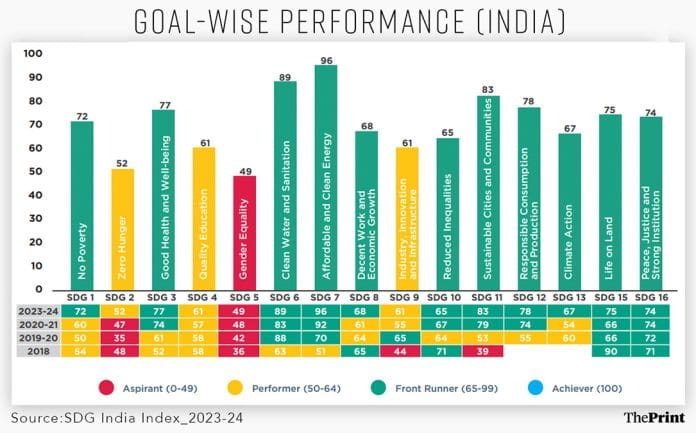New Delhi: India’s overall Sustainable Development Goal (SDG) score on eliminating poverty, providing decent work, economic growth, improving education and healthcare, and other parameters has improved from 66 in 2020-21 to 71 in 2023-24, but there are wide variations among states.
Some like Bihar and Jharkhand have scored as low as 24 and 28, respectively, in SDG 2 (zero hunger) while Bihar and Odisha have scored 32 and 40, respectively, in SDG 4 (quality education), according to a report released by government think-tank NITI Aayog Friday.
There are a total of 16 SDGs directly linked to people’s welfare, well-being and quality of life. The SDGs were adopted in 2015 by all United Nations member countries.
The SDG India Index 2023-24, prepared by NITI Aayog, measures and tracks the progress of all states and UTs on 113 indicators aligned with the Ministry of Statistics and Programme Implementation’s National Indicator Framework. The SDG India Index computes goal-wise scores on the 16 SDGs for each state and UT.
It has ranked Uttarakhand and Kerala as the best performing states among all 16 goals with a score of 79 each, while Bihar was adjudged the worst performer with a score of 57. Among the UTs, Chandigarh was ranked the best performer with a score of 77.
The composite score for each state/UT was computed by aggregating their performance across the goals and by taking the arithmetic mean of individual goal scores. The composite score ranges from 0 to 100 and denotes the overall achievement of the state/UT in achieving the targets under the goals. A score of 100 implies that the state/UT has achieved the targets set for 2030; a score of 0 implies that the particular state/UT is at the bottom of the table.
Releasing the report, NITI Aayog CEO B.V.R. Subrahmanyam said that India’s SDG score has gone up from 57 in 2018 to 71 in 2023-24 but there are wide variations. “In 2024, barring three or four states, it’s a fantastic improvement… if you look at basic indicators, we have improved a lot,” he said.
According to Subrahmanyam, India’s improvement in performance in a large number of areas has happened because of targeted interventions by the government, such as Pradhan Mantri Awas Yojana, Ujjwala scheme, Swachh Bharat Abhiyan, Jan Dhan Yojana, Ayushman Bharat-PMJAY, among others.
But he admitted that there are areas which require more focused intervention.
The index shows that out of the 16 goals, India’s overall score is below 50 only on SDG 5 (gender equality). “There is only one goal where we are still shown as red, where the performance is below 50. This is Goal 5 — gender equality. States which are not doing well have issues like sex ratio… there are states which have below 900 (child sex ratio) even now. That gets reflected here,” the NITI Aayog CEO said.
Goal 5 has 14 states and UTs with a score of less than 50.
Besides, in Goals 2 (zero hunger), 4 (quality education) and 9 (industry, innovation and infrastructure), the overall score is between 50 and 64, indicating opportunity for improvement in the coming years.
Subhrahmanyam said that Odisha and some states in central India need to focus on improving education. “Access to schools is not an issue, it’s the quality,” he said.
Also Read: Niti Aayog at 6 — some ideas too ‘ambitious’ but Modi think tank has many reforms up its sleeve
A look at the report
The SDG India Index 2023-24 scores for states range from 57 to 79, while for UTs they range between 65 and 77. This marks an improvement over the 2020-21 scores, where states ranged from 52 to 75, and UTs ranged from 62 to 79.
According to the report, the top states and UTs that have improved between 2018 and 2023-24 include Uttar Pradesh (increase in score by 25), followed by Jammu and Kashmir (21), Uttarakhand (19), Sikkim (18), Haryana (17), Assam, Punjab and Tripura (16 each), Madhya Pradesh and Odisha (15 each). Besides, 32 states/UTs are in the frontrunner category (scores 65-99), up from 22 states/UTs in 2020-21.
For Goal 1 (no poverty), the national score ranges between 39 and 92 for states and between 58 and 89 for UTs. Tamil Nadu, Dadra and Nagar Haveli and Daman and Diu are the top performers among the states and the UTs, respectively. Only two states — Arunachal Pradesh and Bihar — fall behind with an index score less than 50.
For Goal 2, which measures India’s performance towards achieving zero hunger, the national index score ranges between 24 and 84 for states and between 22 and 84 for UTs. Kerala and Puducherry are the top performers among the states and the UTs, respectively. However, eight states and one UT fall behind, scoring less than 50.
“We need improvement in malnourishment, stunting and body mass index. While there is nobody suffering from lack of food, we need to look if people are getting nutritious food,” Subrahmanyam said.
In Goal 5, which calls for ending all forms of violence, trafficking and sexual exploitation of women and girls, the SDG index score ranges between 39 and 74 for states and between 41 and 65 for UTs. Nagaland and Lakshadweep are the top performers among the states and UTs, respectively. Twelve states and two UTs fell behind, scoring less than 50.
There is also wide variation in Goal 10 that calls for progressively reducing not only income inequalities but also inequalities of outcome by ensuring access to equal opportunities and promoting social, economic and political inclusion of all. The SDG index score for Goal 10 ranges between 43 and 87 for states and between 49 and 80 for UTs. Goa and Puducherry are the top performers among the states and UTs, respectively. However, two states and one UT have scores less than 50.
(Edited by Nida Fatima Siddiqui)
Also Read: How TN topped Niti Aayog’s ‘Export Preparedness Index’, became top investment destination






